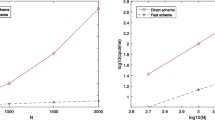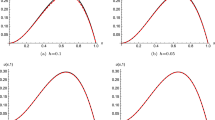Abstract
In this paper, we propose a fast high order method for the time-fractional diffusion equation on unbounded spatial domains. The proposed numerical method is a combination of a time-stepping scheme and spectral method for the spatial discretization. First, we reformulate the unbounded domain problem into a bounded domain problem by introducing suitable artificial boundary conditions. Then the time fractional derivatives involved in the equation and the artificial boundary condition are discretized using the so-called L2 formula and sum-of-exponentials (SOE) approximation. The former has been a popular formula for discretization of the Caputo fractional derivative, while the latter is a computational cost reducing technique frequently employed in recent years for convolution integrals. The spatial discretization makes use of the standard Legendre spectral method. The stability and the accuracy of the full discrete problem are analyzed. Our obtained theoretical results include a rigorous proof of the convergence order for both uniform mesh and graded mesh, and a stability proof for the uniform mesh. Finally, several numerical examples are provided to validate the theoretical results and to demonstrate the efficiency of the proposed method.





Similar content being viewed by others
Data Availibility
Data will be made available on request.
References
Alikhanov, A.: A new difference scheme for the time fractional diffusion equation. J. Comput. Phys. 280, 424–438 (2015)
Antoine, X., Arnold, A., Besse, C.: A review of transparent and artificial boundary conditions techniques for linear and nonlinear schr\(\ddot{\text{ o }}\)dinger equations. Commun. Comput. Phys. 4(4), 729–796 (2008)
Baffet, D., Hesthaven, J.: High-order accurate adaptive kernel compression time-stepping schemes for fractional differential equations. J. Sci. Comput. 72(3), 1169–1195 (2017)
Baffet, D., Hesthaven, J.: A kernel compression scheme for fractional differential equations. SIAM J. Numer. Anal. 55(2), 496–520 (2017)
Bernardi, C., Maday, Y.: Approximations spectrales de problémes aux limites elliptiques. Springer, Berlin (1992)
Dixon, J., McKee, S.: Weakly singular discrete Gronwall inequalities. ZAMM Z. Angew. Math. Mech. 66, 535–544 (1986)
Ford, N., Yan, Y.: An approach to construct higher order time discretisation schemes for time fractional partial differential equations with nonsmooth data. Fract. Calc. Appl. Anal. 20(5), 1076–1105 (2017)
Gao, G., Sun, Z.: The finite difference approximation for a class of fractional sub-diffusion equations on a space unbounded domain. J. Comput. Phys. 236(1), 443–460 (2013)
Gao, G., Sun, Z., Zhang, H.: A new fractional numerical differentiation formula to approximate the Caputo fractional derivative and its applications. J. Comput. Phys. 259(2), 33–50 (2014)
Gao, G., Sun, Z., Zhang, Y.: A finite difference scheme for fractional sub-diffusion equations on an unbounded domain using artificial boundary conditions. J. Comput. Phys. 231(7), 2865–2879 (2012)
Gorenflo, R., Mainardi, F., Moretti, D., Paradisi, P.: Time fractional diffusion: a discrete random walk approach. Nonlinear Dynam. 29(1–4), 129–143 (2002)
Han, H., Wu, X.: Approximation of infinite boundary condition and its application to finite element methods. J. Comput. Math. 3(2), 179–192 (1985)
Han, H., Zhu, L., Brunner, H., Ma, J.: Artificial boundary conditions for parabolic Volterra integro-differential equations on unbounded two-dimensional domains. J. Comput. Appl. Math. 197(2), 406–420 (2006)
Jiang, S., Zhang, J., Zhang, Q., Zhang, Z.: Fast evaluation of the Caputo fractional derivative and its applications to fractional diffusion equations. Commun. Comput. Phys. 21(3), 650–678 (2017)
Kilbas, A., Srivastava, H., Trujillo, J.: Theory and applications of fractional differential equations, vol. 204. Elsevier, Amsterdam (2006)
Kochubei, A., Luchko, Y.: Handbook of fractional calculus with applications. Volume 1: basic theory. De Gruyter (2019)
Liao, H., Liu, N., Zhao, X.: Asymptotically compatible energy of variable-step fractional BDF2 formula for time-fractional Cahn-Hilliard model. arXiv:2210.12514v1. 1–21 (2022)
Lin, Y., Xu, C.: Finite difference/spectral approximations for the time-fractional diffusion equation. J. Comput. Phys. 225(2), 1533–1552 (2007)
Lubich, C.: Discretized fractional calculus. SIAM J. Math. Anal. 17(3), 704–719 (1986)
Lubich, C.: Convolution Quadrature and Discretized Operational Calculus: Convolution quadrature and discretized operational calculus. I. Numer. Math. 52(2), 129–145 (1988)
Lv, C., Xu, C.: Improved error estimates of a finite difference/spectral method for time-fractional diffusion equations. Int. J. Numer. Anal. Mod. 12(2), 384–400 (2015)
Lv, C., Xu, C.: Error analysis of a high order method for time-fractional diffusion equation. SIAM J. Sci. Comput. 38(5), A2699–A2724 (2016)
McLean, W.: Fast summation by interval clustering for an evolution equation with memory. J. Sci. Comput. 34(6), A3039–A3056 (2012)
Metzler, R., Klafter, J.: The random walk’s guide to anomalous diffusion: a fractional dynamics approach. Phys. Rep. 339(1), 1–77 (2000)
Quan, C., Wu, X.: \(H^1\)-stability of an L2-type method on general nonuniform meshes for subdiffusion equation. arXiv:2205.06060v1. 1–31 (2023)
Quarteroni, A., Valli, A.: Numerical approximation of partial differential equations. Springer, Berlin (1997)
Sakamoto, K., Yamamoto, M.: Initial value/boundary value problems for fractional diffusion-wave equations and applications to some inverse problems. J. Math. Anal. Appl. 382(1), 426–447 (2011)
Stynes, M., O’Riordan, E., Gracia, J.: Error analysis of a finite difference method on graded meshes for a time-fractional diffusion equation. SIAM J. Numer. Anal. 55(2), 1057–1079 (2017)
Sun, Z., Wu, X.: A fully discrete difference scheme for a diffusion-wave system. Appl. Numer. Math. 56(2), 193–209 (2006)
Tsynkov, S.: Numerical solution of problems on unbounded domains: a review. Appl. Numer. Math. 27(4), 465–532 (1998)
Yan, Y., Sun, Z., Zhang, J.: Fast evaluation of the Caputo fractional derivative and its applications to fractional diffusion equations: A second-order scheme. Commun. Comput. Phys. 22(4), 1028–1048 (2017)
Zeng, F., Turner, I., Burrage, K.: A stable fast time-stepping method for fractional integral and derivative operators. J. Sci. Comput. 77(1), 283–307 (2018)
Zeng, F., Zhang, Z., Karniadakis, G.: Second-order numerical methods for multi-term fractional differential equations: smooth and non-smooth solutions. Comput. Methods Appl. Mech. Eng. 327, 478–502 (2017)
Zhang, Q., Zhang, J., Jiang, S., Zhang, Z.: Numerical solution to a linearized time fractional KdV equation on unbounded domians. Math. Comput. 87(310), 693–719 (2018)
Zheng, C., Wen, X., Han, H.: Numerical solution to a linearized KdV equation on unbounded domian. Numer. Methods Partial Differ. Equ. 24(2), 383–399 (2010)
Zhu, H., Xu, C.: A fast high order method for the time-fractional diffusion equation. SIAM J. Numer. Anal. 57(6), 2829–2849 (2019)
Funding
The work of Hongyi Zhu is supported by the National Natural Science Foundation of China grant 12001238, China Postdoctoral Science Foundation funded project grant 2021M691248. Chuanju Xu is supported by the National Natural Science Foundation of China grant 12371408.
Author information
Authors and Affiliations
Contributions
HZ: Conceptualization, Methodology, Software, Validation, Writing-original draft. CX: Conceptualization, Methodology, Supervision, Writing-review and editing.
Corresponding author
Ethics declarations
Conflict of interest
The authors declare that they have no Conflict of interest concerning the publication of this manuscript.
Additional information
Publisher's Note
Springer Nature remains neutral with regard to jurisdictional claims in published maps and institutional affiliations.
Appendix
Appendix
To prove Lemma 3.3, the following Lemma presenting properties of the coefficients \(d^{k,\alpha }_{k-j}\) will be needed, we refer to [36] for proof.
Lemma 7.1
For any \(0<\alpha <1\), \(k\ge 3\), \(n\ge k\), the coefficients \(d^{k,\alpha }_{k-j}\) in (3.16) satisfy
-
(1)
\(\displaystyle 0< d^{k,\alpha }_{k-1} < \frac{4}{3};\)
-
(2)
\(\displaystyle -\frac{1}{2}< d^{k,\alpha }_{k-2}<\frac{1}{3} \);
-
(3)
\(\displaystyle d^{k,\alpha }_{k-j} > 0,j=3,\dots ,k;\)
-
(4)
\(\displaystyle \sum ^{k}_{j=1}d^{k,\alpha }_{k-j}=1;\)
-
(5)
\(\displaystyle \sum ^{n}_{k=2}{d}^{k,\alpha }_{0}\le (2-\alpha )(n-1)^{1-\alpha };\)
-
(6)
\(\displaystyle \sum ^{n}_{k=2}{d}^{k,\alpha }_{1}\le \displaystyle \frac{4}{3}+(2-\alpha )(n-2)^{1-\alpha };\)
-
(7)
\(\displaystyle \sum ^{n}_{k=j+1}{d}^{k,\alpha }_{j}\le 1, \ j=2,\dots , n-2\);
-
(8)
\(d^{k,\alpha }_{k-j}=d^{k+1,\alpha }_{k-j+1}, j=1,\ldots ,k-2\).
Proof of Lemma 3.3
We start with proving (i). We only prove (i.1) since (i.2)–(i.5) can be proved in a similar way as Lemma 3.2.
-
For \(k\ge 4\), it follows from (3.2) (3.3) and (3.18) that
$$\begin{aligned} \displaystyle \overline{d}^{k,{\alpha /2}}_{k-1}= & {} {d}^{k,{\alpha /2}}_{k-1} -\frac{1}{2}{d}^{k,\alpha }_{k-1}=3-\frac{{\alpha /2}+4}{{\alpha /2}+2}{\big (\frac{3}{2}\big )}^{1-{\alpha /2}} -\frac{1}{2}\Big [3-\frac{\alpha +4}{\alpha +2}{\big (\frac{3}{2}\big )}^{1-\alpha }\Big ],\\ \displaystyle \overline{d}^{k,{\alpha /2}}_{k-2}= & {} {d}^{k,{\alpha /2}}_{k-2}+\eta ({d}^{k,{\alpha /2}}_{k-1}-\eta )\\= & {} \displaystyle \frac{\alpha +8}{\alpha +4}{\big (\frac{3}{2}\big )}^{2-{\alpha /2}} +\frac{1}{2}\frac{\alpha +8}{\alpha +2}{\big (\frac{3}{2}\big )}^{2-3{\alpha /2}} -\frac{1}{4}{\big (\frac{\alpha +4}{\alpha +2}\big )}^2{\big (\frac{3}{2}\big )}^{2-2\alpha }\\{} & {} -\frac{3}{4} -\frac{\alpha +12}{\alpha +4}2^{1-{\alpha /2}}. \end{aligned}$$Now we show \(\overline{d}^{k,{\alpha /2}}_{k-i}>0 \ (i=1,2)\) one by one. Let \(\displaystyle g(x)=3-\frac{x+4}{x+2}{\big (\frac{3}{2}\big )}^{1-x}\), since the derivative function \(\displaystyle g'(x)={(\frac{3}{2})}^{1-x}\Big [\frac{2}{{(x+2)}^2}+\frac{x+4}{x+2}\ln \frac{3}{2}\Big ]\) is decreasing on [0, 1], then
$$\begin{aligned}\displaystyle \overline{d}^{k,{\alpha /2}}_{k-1}=g({\alpha /2})-\frac{1}{2}g(\alpha ) =g(\frac{\alpha +0}{2})-\frac{g(\alpha )+g(0)}{2}>0.\end{aligned}$$Next, a careful calculation shows
$$\begin{aligned}{} & {} \displaystyle 2^{3+\alpha /2}(\alpha +2)^2(\alpha +4)\overline{d}^{k,{\alpha /2}}_{k-2}\\{} & {} \quad =\displaystyle 2^{{\alpha /2}}\big [18{(\alpha +2)}^2(\alpha +8)\big (\frac{3}{2}\big )^{-{\alpha /2}} +9(\alpha +2)(\alpha +4)(\alpha +8)\big (\frac{3}{2}\big )^{-3{\alpha /2}}\\{} & {} \qquad \displaystyle -\frac{9}{2}{(\alpha +4)}^3\big (\frac{3}{2}\big )^{-2\alpha }-6{(\alpha +2)}^2(\alpha +4)\big ] -16{(\alpha +2)}^2(\alpha +12)\\{} & {} \quad \ge \displaystyle \big (1+\frac{\alpha }{3}+\frac{1}{13}{\alpha }^2+\frac{1}{255}{\alpha }^3\big )\Big \{18{(\alpha +2)}^2(\alpha +8) \big [1+\sum _{i=1}^9\frac{(-\frac{\alpha }{2})\cdots (-\frac{\alpha }{2}-i+1)}{i!}\frac{1}{2^i}\big ]\\{} & {} \qquad +\displaystyle 9(\alpha +2)(\alpha +4)(\alpha +8)\big [1+\sum _{i=1}^9 \frac{(-\frac{3\alpha }{2})\cdots (-\frac{3\alpha }{2}-i+1)}{i!}\frac{1}{2^i}\big ]\\{} & {} \qquad \displaystyle -\frac{9}{2}{(\alpha +4)}^3\big [1+\sum _{i=1}^{10} \frac{(-2\alpha )\cdots (-2\alpha -i{+}1)}{i!}\frac{1}{2^{i}}\big ] -6{(\alpha +2)}^2(\alpha +4)\Big \}-16{(\alpha +2)}^2(\alpha +12)\\{} & {} \quad =\displaystyle \frac{89}{14}\alpha -\frac{1017593}{436800}\alpha ^2+\alpha ^3\Big (\frac{6796887131}{712857600}-\frac{75894521561}{17108582400}\alpha -\frac{74831376457}{26320896000}\alpha ^2\\{} & {} \qquad -\frac{1623224922073}{1368686592000}\alpha ^3-\frac{3521490017653}{5474746368000}\alpha ^4\\{} & {} \displaystyle -\frac{2854730671973}{10949492736000}\alpha ^5-\frac{75386416843}{912457728000}\alpha ^6-\frac{10640668967}{521404416000}\alpha ^7-\frac{20152333777}{5152702464000}\alpha ^8\\{} & {} \qquad -\frac{99934568449}{175191883776000}\alpha ^9\displaystyle -\frac{10839693427}{175191883776000}\alpha ^{10}-\frac{817537909}{175191883776000}\alpha ^{11}\\{} & {} \qquad -\frac{1439423}{6488588288000}\alpha ^{12}-\frac{1}{205632000}\alpha ^{13}\Big )\\\ge & {} \displaystyle \frac{89}{14}\alpha -\frac{1017593}{436800}\alpha ^2 \ge \alpha >0. \end{aligned}$$Furthermore, it can be verified that
$$\begin{aligned} \overline{d}^{k,{\alpha /2}}_{k-j}={d}^{k,{\alpha /2}}_{k-j}+\eta \overline{d}^{k,{\alpha /2}}_{k-j+1}, \quad j=3,\ldots ,k. \end{aligned}$$Then it follows from Lemma 7.1(3) that \(\overline{d}^{k,{\alpha /2}}_{k-j}>0\), \(j=3,\ldots ,k\).
-
For \(k=3\). We find from (3.2) that \({d}^{3,{\alpha /2}}_{2}={d}^{4,{\alpha /2}}_{3}\), \({d}^{3,{\alpha /2}}_{1}>{d}^{4,{\alpha /2}}_{2}\), \({d}^{3,{\alpha /2}}_{0}>0\). As a consequence,
$$\begin{aligned} \begin{array}{lcl} &{}&{}\overline{d}^{3,{\alpha /2}}_{2}=\overline{d}^{4,{\alpha /2}}_{3}>0,\\ &{}&{}\overline{d}^{3,{\alpha /2}}_{1}={d}^{3,{\alpha /2}}_{1}+\eta ({d}^{3,{\alpha /2}}_{2}-\eta )>{d}^{4,{\alpha /2}}_{2}+\eta ({d}^{4,{\alpha /2}}_{3}-\eta )=\overline{d}^{4,{\alpha /2}}_{2}>0,\\ &{}&{}\overline{d}^{3,{\alpha /2}}_{0}={d}^{3,{\alpha /2}}_{0}+\eta \overline{d}^{3,{\alpha /2}}_{1}>0. \end{array} \end{aligned}$$ -
For \(k=2\), a direct calculation using (3.2) gives
$$\begin{aligned}{} & {} \overline{d}^{2,{\alpha /2}}_{1}={d}^{2,{\alpha /2}}_{1}-\eta \ge \frac{2\alpha ^2}{(\alpha +2)(\alpha +4)}>0,\\{} & {} \overline{d}^{2,{\alpha /2}}_{0} ={d}^{2,{\alpha /2}}_{0}+\eta \overline{d}^{2,{\alpha /2}}_{1} \ge {d}^{2,{\alpha /2}}_{0} =\frac{4-3\alpha }{4+\alpha }>0. \end{aligned}$$
(ii) By (3.18), we get \(\displaystyle \overline{d}^{k,\beta }_{0}=\sum ^{k}_{j=1}\eta ^{k-j}{d}^{k,\beta }_{k-j}-\eta ^{k}\). Using Lemma 7.1(5)(6)(7), and noticing that \(\displaystyle \eta =\frac{1}{2}\big [3-\frac{\alpha +4}{\alpha +2}(\frac{3}{2})^{1-\alpha }\big ]\in (0,\frac{2}{3})\), we obtain
(iii) Noticing \(\displaystyle \overline{d}^{k,\beta }_{1}=\sum ^{k-1}_{j=1}\eta ^{k-j-1}{d}^{k,\beta }_{k-j} -\eta ^{k-1}\), we follow similar lines as (ii) to deduce:
(iv) According to Lemma 7.1(8) and the definition of \(\overline{d}^{k,\beta }_{k-j}\) in (3.18), it is seen that
Then using Lemma 3.2(1) and (3), Lemma 3.3(i.1) and (i.3), we obtain: for \(j=2,\dots ,n-1\),
(v) and (vi) can be derived directly from Lemma 3.3(i.4) and (i.5). \(\square \)
Rights and permissions
Springer Nature or its licensor (e.g. a society or other partner) holds exclusive rights to this article under a publishing agreement with the author(s) or other rightsholder(s); author self-archiving of the accepted manuscript version of this article is solely governed by the terms of such publishing agreement and applicable law.
About this article
Cite this article
Zhu, H., Xu, C. A Highly Efficient Numerical Method for the Time-Fractional Diffusion Equation on Unbounded Domains. J Sci Comput 99, 47 (2024). https://doi.org/10.1007/s10915-024-02508-2
Received:
Revised:
Accepted:
Published:
DOI: https://doi.org/10.1007/s10915-024-02508-2
Keywords
- Time fractional diffusion equation
- Unbounded domain
- Artificial boundary conditions
- Time stepping scheme
- Error estimate




